How to Install Led Strip Lights in False Ceiling

Positioning LED Tapes – tips for covings, plinths, cabinets and more
To get the very best effect from your LED feature lights, you'll need to think about the best placement. On this support page, we'll offer some quick and easy tips on how to create the best lighting effect with drop ceilings, coving and cornices, plinths and kickboards, and kitchen/bathroom cabinets.

How to install LED strip lights on drop-down ceilings

Drop-down ceilings are a kind of decorative ceiling feature, suspended so they sit lower than the main (structural) ceiling around the centre of the room, and leaving a gap around the edge of the wall. Also known as false ceilings, drop ceilings and suspended ceilings, they're an excellent location for LED feature lighting.
The design of drop-down ceilings can vary, but they're typically suspended with a drop of around 10cm-15cm, and the same distance from the surrounding walls.
When installing your strip lights, there are two options for positioning the LED tape:
- LED tape can be fitted horizontally, facing upwards. (fig 1)
- Or LED tape can be fitted vertically, facing sideways. (fig 2)

fig 1 – LEDs placed horizontally

fig 2 – LEDs placed vertically
Whichever you choose, the essential key to an effective LED installation is to make sure the LEDs are located behind a lip, at the edge of your drop-ceiling. The lip should be higher than the LED tape (say 15mm at least). This will give a much better effect – by hiding the LEDs themselves, so you'll see only their light and not the light-source.
If you choose to fit horizontally, it's best to stick the LED as close as possible behind the lip of the drop-ceiling, in order to avoid light-dots shining on the vertical surface behind.

fig 3 – always place LEDs behind a lip
How to install LED strip lights on coving and cornices

Coving comes in all shapes and sizes. Generally it refers to decorative mouldings located at the junction between walls and ceilings. Hollow coving creates a great location to install LED highlights.
If you are fitting/moulding your own coving, you can choose how far down from the ceiling you want it. Once your coving is in place, a good tip for positioning your LED tape is to fix it as far from the back wall as you can, so as to avoid seeing visible light-dotting.
(Try to fit your coving so the LEDs will sit at least 100mm down from the ceiling, and at least 50mm from the wall.)

fig 4 – placement of LEDs with coving
Also, make sure there's a lip on the coving, to hide the LEDs. This is key to creating a much better effect, by displaying just the light and not the light-source. A lip roughly 20mm in depth is ideal.

Alternatively, you can fit your LED strips to one of our moulded picture rails. Specifically designed to accommodate our LED tape range, they enable you to angle the lights away from the wall.
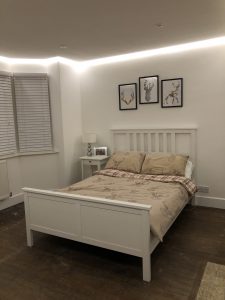
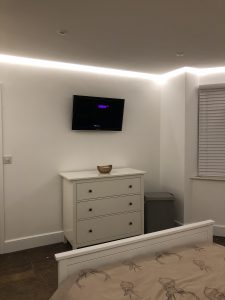
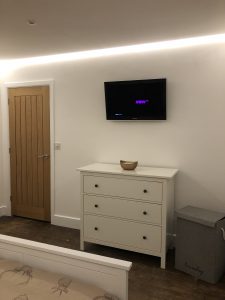
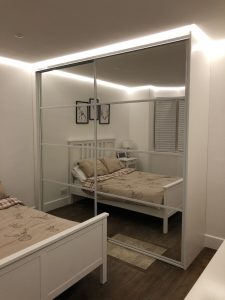
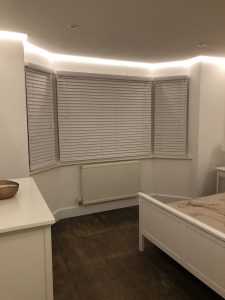
How to install LED strip lights on plinths and kickboards
Plinths and kickboards (aka skirting) are usually already in place in kitchens and in other locations.
A few tips for LED installations:
- Don't position your LED tape too close to a wall, or else you may see lighting-dotting.
- If possible, try to position your LEDs behind a lip, in order to hide the LED light source.
- Be careful of the floor surface that the lights are going to fall on. Shining LED strip lights onto reflective floor tiles can create a reflection, which can sometimes be less attractive than a smooth wash effect. (If this is a problem, you should consider using our deep surface extrusions or tube surface extrusions, which will diffuse the LEDs' light so it appears like a continuous light-bar rather than a line of dots.)
- For the very best effect, stick the LED tape behind a lip at the front edge of your plinth or kickboard, facing downwards.

fig 5 – kickboard & plinth LED placement
How to install LED strip lights under kitchen cabinets and bathroom cabinets
By installing LED strips under your kitchen cabinets, you can create striking feature-light effects or more powerful task light for when you're cooking.
As with other location, the best effect will be achieved if you can place your LEDs behind a lip (fig 6). But if you don't have a lip on the cabinet, then a typical cabinet is usually deep enough to let you place the LEDs further back, out of sight (fig 7).

fig 6 – LEDs under cabinet with lip
Either way, LEDs produce a wide beam of 120 degrees that will shine all the way to the back and front of your cabinet.
If your work-surface is shiny, be careful of unwanted reflections. If required, you can use extrusions to diffuse your LEDs' dotting effect.

fig 7 – LEDs under cabinet with no lip

fig 8 – typical LED wiring for bookcases
The best effect is usually achieved by fixing your LED strips to provide downlight (i.e., installed facing downwards on the underside of your shelves). As with cabinet projects (fig 6 and fig 7 above), be sure to position the LED strips behind a lip, or if there is no lip then the strips should be placed further back, so they are out of sight.
The typical wiring solution for most bookcase/shelving projects is to use an electrical connector block. This splits the power feed from the LED transformer, in order to provide multiple parallel feeds to each LED strip (fig 8).
For more information on connector-blocks, see our connecting LED tapes support page.
Alternatively, LED strips can be serially connected, using flexible connections hidden out of sight. InStyle can solder these connections for you before delivery, or if you prefer you can fit your own connections by using our clip-on LED tape flexible connectors.
NB Connecting too many shelving LED strips in serial can cause voltage drop, which may result in your LEDs appearing dim and underpowered. To avoid voltage drop, we recommend that no run of LED tape should exceed 6 metres. This may require splitting your shelving lights into more than one run (as shown in fig 9).

fig 9 – alternative LED wiring for bookcases

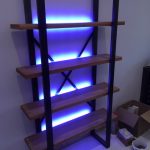
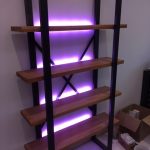
Share this page!
-
Send Me InStyle Product Mailings
How to Install Led Strip Lights in False Ceiling
Source: https://www.instyleled.co.uk/support/position-led-strips-on-drop-ceilings-coving-plinths-kickboards-cabinets/